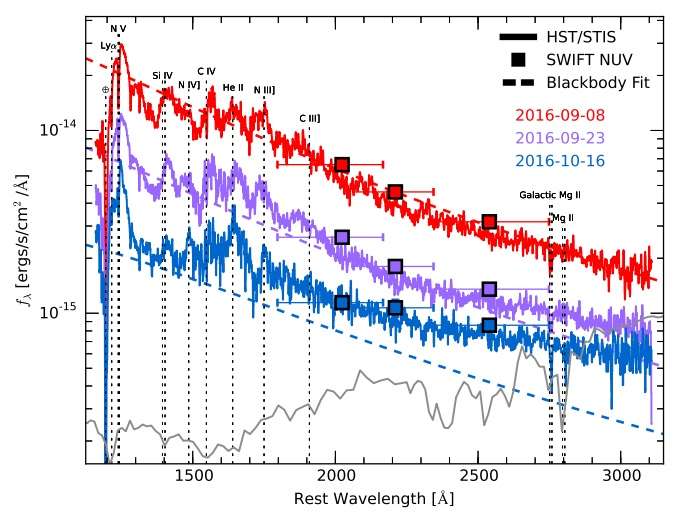April 19, 2017 report
Ultraviolet spectroscopic evolution of a tidal disruption event investigated by astronomers

(Phys.org)—An international team of astronomers led by Jonathan S. Brown of the Ohio State University in Columbus, Ohio, has studied the ultraviolet spectroscopic evolution of a nearby low-luminosity tidal disruption event (TDE) known as iPTF16fnl. The results of this study, published Apr. 7 on arXiv.org., offer new clues on the nature of this TDE.
TDE occurs when a star passes close enough to a supermassive black hole and is pulled apart by the black hole's tidal forces, causing the process of disruption. Such tidally disrupted stellar debris then rains down on the black hole and radiation emerges from the innermost region of accreting debris, which indicates the presence of a TDE.
TDEs serve as invaluable probes of strong gravity and accretion physics, providing answers about the formation and evolution of supermassive black holes. While most such events are discovered in optical transient surveys, ultraviolet observations provide an opportunity to learn much more about the kinematics and ionization structure of tidally disrupted stellar debris.
iPTF16fnl was discovered on Aug. 26, 2016 as a transient consistent with the center of the galaxy Mrk 0950. This transient was later classified as a rapidly evolving, low-luminosity TDE, located about 220 million light years away. It is the nearest TDE found so far and its black hole mass is estimated to be not greater than 5.5 million solar masses.
Due to the proximity of iPTF16fnl to Earth, Brown and his colleagues decided to initiate a follow-up observational campaign in order to study this event in detail. These observations were conducted using the Hubble Space Telescope's (HST) Space Telescope Imaging Spectrograph (STIS) and the Ultraviolet/Optical Telescope (UVOT) onboard NASA's Swift spacecraft. The researchers also employed several ground-based observatories in order to perform photometric and spectroscopic monitoring of this event. All these instruments allowed the team to spectroscopically observe the temporal evolution of a TDE in ultraviolet light for the first time ever.
"We presented for the first time the UV spectroscopic evolution of a TDE using data from HST/STIS," Brown's team wrote in a research paper available on arXiv.org.
The results show that shape and velocity offset of the broad ultraviolet emission in iPTF16fnl and absorption features evolve with time.
"There is significant evolution in the shape and central wavelength of the line profiles over the course of our observations, such that at early times, the lines are broad and redshifted, while at later times, the lines are significantly narrower and peak near the wavelengths of their corresponding atomic transitions," the paper reads.
The researchers found that ultraviolet spectra of iPTF16fnl closely resemble those of ASASSN-14li (other nearby TDE) and nitrogen-rich quasars. When it comes to optical spectra of iPTF16fnl, the findings indicate that they resemble those of several other optically discovered TDEs.
"The dominant emission features closely resemble those seen in the UV spectra of the TDE ASASSN-14li and are also similar to those of N-rich quasars," the authors wrote.
All the data obtained by various space and ground-based telescopes allowed the scientists to draw conclusion that iPTF16fnl is subluminous and evolves more rapidly than other optically detected TDEs.
More information: The Ultraviolet Spectroscopic Evolution of the Low-Luminosity Tidal Disruption Event iPTF16fnl, arXiv:1704.02321 [astro-ph.HE] arxiv.org/abs/1704.02321
Abstract
We present the ultraviolet (UV) spectroscopic evolution of a tidal disruption event (TDE) for the first time. After the discovery of the nearby TDE iPTF16fnl, we obtained a series of observations with the Space Telescope Imaging Spectrograph (STIS) onboard the Hubble Space Telescope (HST). The dominant emission features closely resemble those seen in the UV spectra of the TDE ASASSN-14li and are also similar to those of N-rich quasars. However, there is significant evolution in the shape and central wavelength of the line profiles over the course of our observations, such that at early times the lines are broad and redshifted, while at later times the lines are significantly narrower and peak near the wavelengths of their corresponding atomic transitions. Like ASASSN-14li, but unlike N-rich quasars, iPTF16fnl shows neither MgIIλ2798AA nor CIII]λ1909AA emission features. We also present optical photometry and spectroscopy, which suggest that the complex HeII profiles observed in the optical spectra of many TDEs are in part due to the presence of NIII and CIII Wolf-Rayet features, which can potentially serve as probes of the far-UV when space-based observations are not possible. Finally, we use Swift XRT and UVOT observations to place strong limits on the X-ray emission and determine the characteristic temperature, radius, and luminosity of the emitting material. We find that iPTF16fnl is subluminous and evolves more rapidly than other optically discovered TDEs.
© 2017 Phys.org




















